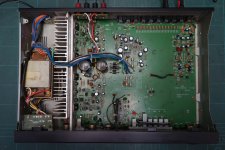Hello.
integrated Amplifier NAD 302.
Power on but
Blown fuses F503 and F504.
All power transistors desoldered and tested OK.
Transformer dead?
SM
https://www.google.com/url?sa=t&sou...FjAAegQIAhAC&usg=AOvVaw3WfGWps9RkIUq8JCRSmC64
integrated Amplifier NAD 302.
Power on but
Blown fuses F503 and F504.
All power transistors desoldered and tested OK.
Transformer dead?
SM
https://www.google.com/url?sa=t&sou...FjAAegQIAhAC&usg=AOvVaw3WfGWps9RkIUq8JCRSmC64
With the fuses removed what AC voltage do you get from the transformer --have you tested for that FIRST ?
Also which section of the power supply is dead ( if at all ) as you have a higher voltage stabilized feed and a slightly lower non- stabilized feed on separate winding's of the transformer --both sections have their own twin fuses ?
Also which section of the power supply is dead ( if at all ) as you have a higher voltage stabilized feed and a slightly lower non- stabilized feed on separate winding's of the transformer --both sections have their own twin fuses ?
On the transformer winding's with a simple diode bridge and no stabilization you should get approx 33Volts DC +/- output and the output from the stabilized winding,s approx 28 Volts DC +/-.
At the input to the fuses you should get a higher AC voltage than the DC output of each supply .
At the input to the fuses you should get a higher AC voltage than the DC output of each supply .
This amp I know. Most reason are faulty caps C508/C509 and S502 for switching the secondary winding for two different supply voltage.
Replace the caps, check the rectifiers D505-508 and remove S502 (solder connections for 4 Ohm impedance).
Now the next steps are as follow:
1) Introduce bypass resistors around 10-15K in parallel to C508/509
2) Disconnect the power amplifier stages from the power supply in such kind, that only transformer, fuses D505-508 and C508/509 are in operating after switch on.
If fuses blown again, check PCB-traces. If don't blown, check resistances between pos. rail and GND so as negative rail and GND to the power amp stages.
If resistances below 2-3K-ohms, you can connect again the power amps to the voltage supply after discharge C508/C509 for start usual troubleshooting
Replace the caps, check the rectifiers D505-508 and remove S502 (solder connections for 4 Ohm impedance).
Now the next steps are as follow:
1) Introduce bypass resistors around 10-15K in parallel to C508/509
2) Disconnect the power amplifier stages from the power supply in such kind, that only transformer, fuses D505-508 and C508/509 are in operating after switch on.
If fuses blown again, check PCB-traces. If don't blown, check resistances between pos. rail and GND so as negative rail and GND to the power amp stages.
If resistances below 2-3K-ohms, you can connect again the power amps to the voltage supply after discharge C508/C509 for start usual troubleshooting
Attachments
So you have confirmed that the AC voltages are okay ?
Also the fuses no longer blow --or do they ?
Logical/basic steps .
Also the fuses no longer blow --or do they ?
Logical/basic steps .
Its solved.
Resistors fuses R437 & R438 was dead.
After replacing Amplifier works fine.
Thank you very much.
Resistors fuses R437 & R438 was dead.
After replacing Amplifier works fine.
Thank you very much.
I am glad you managed to locate the fault and repair it this sort of learning sticks in your brain for any future audio problems .
All of us are learning it never ends.
Good listening.
All of us are learning it never ends.
Good listening.
Any reason therefore ? To find out this is important, otherwise the same fault occurs sometime soon.Its solved.
Resistors fuses R437 & R438 was dead.
After replacing Amplifier works fine.
Thank you very much.
Maybe too high current through Q407/408 (BD139) at both channels (temporarily RF oscillation ?).
- Home
- Amplifiers
- Solid State
- NAD 302 fuse blown
